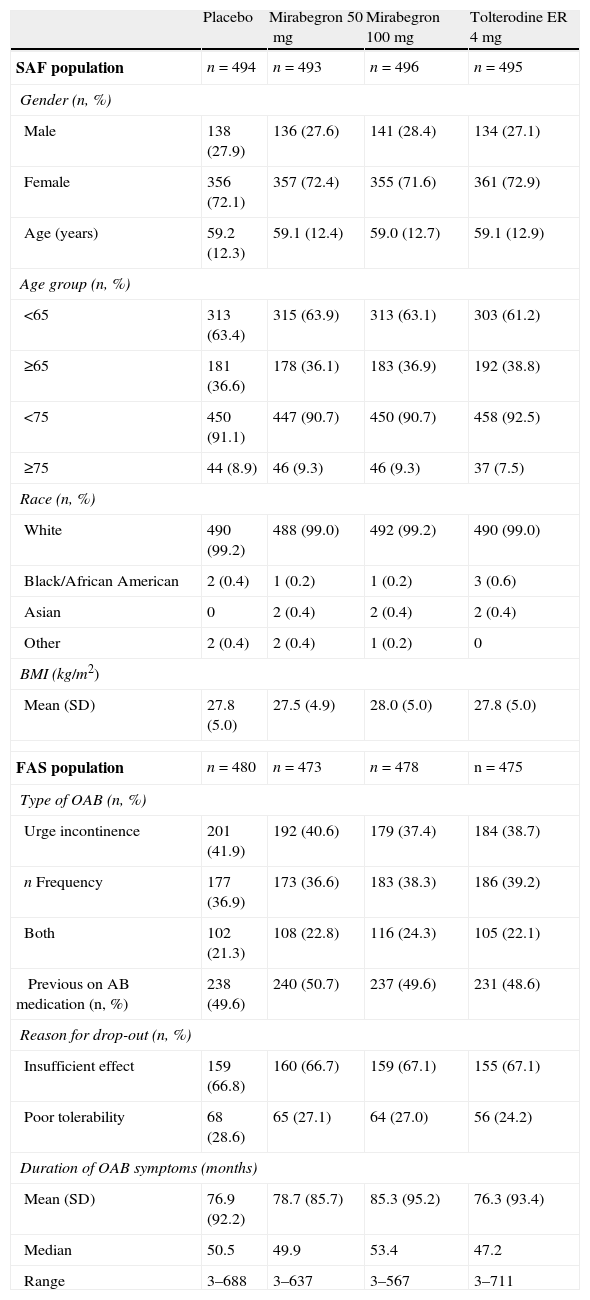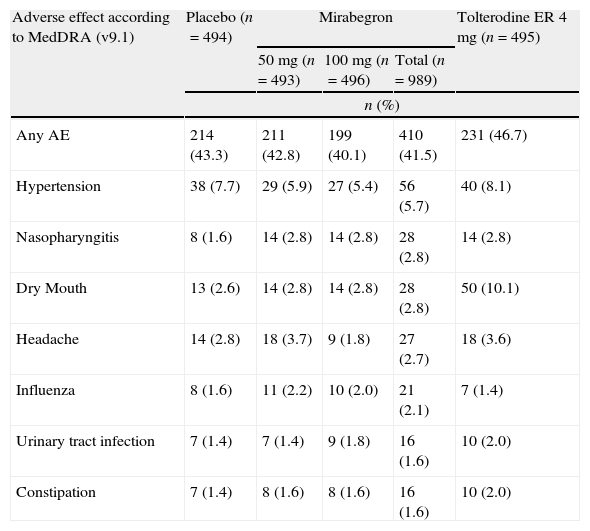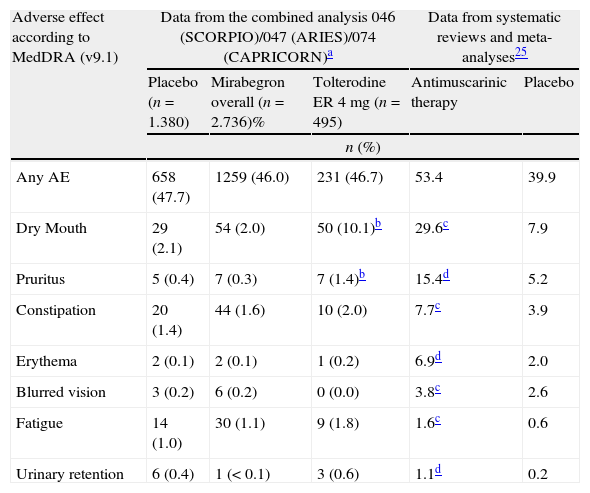Mirabegron, the selective β3-adrenoceptor agonist, heralds the latest development for the treatment of overactive bladder (OAB).
ObjectiveTo present the evidence available on the efficacy and tolerability of mirabegron and to discuss this treatment's potential in our setting.
Evidence acquisitionWe reviewed 11 studies conducted with mirabegron in patients with OAB (2 phase ii, 9 phase iii), all studies were compared to placebo with 6 studies also including tolterodine as an additional arm. Greater emphasis shall be given to the main phase iii trials performed in Europe, the USA and Australia evaluating efficacy and safety after 12 weeks (NCT00662909, NCT00689104, NCT00912964) and safety after 12 months (NCT00688688). The combined analyses of these 12-week studies are also available, with emphasis on global efficacy (FAS), efficacy with regard to incontinence (FAS i) and safety (SAF). More than 50% of patients had previously discontinued anticholinergics medication for OAB, thus allowing us to obtain data on the effectiveness of mirabegron in patients already treated with anticholinergics.
Evidence synthesisMirabegron is an efficacious drug which presents a statistically significant reduction in the number of incontinence episodes and in urinary frequency as of 4 weeks, with a higher percentage of dry patients and a higher percentage of patients with reduction ≥50% in the number of incontinence episodes than placebo. The efficacy of mirabegron 50 and 100mg in the reduction of incontinence episodes occurs in de novo patients and who have received antimuscarinics, with adjusted mean difference and improvement in urinary frequency greater in treated patients. Its tolerability is very similar to placebo particularly for the adverse effects of the antimuscarinics (dry mouth, constipation and blurred vision). A minimal, non-clinically significant change is observed in systolic and diastolic blood pressure and pulse. Its efficacy is long-term. Mirabegron at the doses of 50 and 100mg presents an improvement versus placebo in patient satisfaction, health-related quality of life (HRQoL), symptom bother and patient's perception of bladder condition (PPBC). In the 12-week phase III European study tolterodine deliverred a lesser degree of improvement than mirabegron versus placebo in patient satisfaction, HRQoL, symptom bother and PPBC.
ConclusionsMirabegron is the first of a new class of compounds with a novel mechanism of action that is different to the antimuscarinics. It presents significant and clinically important efficacy in the treatment of the symptoms of OAB. It has advantages with regard to the results described by the patient in treatment satisfaction. Studies on its combined use with anticholinergics are ongoing.
Mirabegrón, agonista adrenorreceptor β3, supone el último desarrollo farmacológico para el tratamiento de la vejiga hiperactiva (VH).
ObjetivoPresentar la evidencia disponible respecto a la eficacia y tolerancia de mirabegrón y discutir el potencial de dicho tratamiento en nuestro entorno.
Adquisición de evidenciaSe revisan 11 estudios llevados a cabo con mirabegrón en pacientes con VH (2 fase ii, 9 fase iii), todos en comparación con placebo y 6 de ellos incluyeron también tolterodina como brazo adicional. Se hace mayor énfasis en los principales ensayos fase iii llevados a cabo en Europa, EE. UU. y Australia que evalúan la eficacia y seguridad a 12 semanas (NCT00662909, NCT00689104, NCT00912964) y la seguridad a 12 meses (NCT00688688). Se dispone también del análisis combinado de dichos estudios a 12 semanas, enfatizando en la eficacia global (FAS), la eficacia relativa a la incontinencia (FAS-i) y la seguridad (SAF). Más del 50% de los pacientes había abandonado previamente la medicación anticolinérgica para VH, lo que permite también obtener datos acerca de la efectividad de mirabegrón en pacientes tratados previamente con anticolinérgicos.
Síntesis de evidenciaMirabegrón es un fármaco eficaz que muestra una reducción estadísticamente significativa en número de episodios de incontinencia y en frecuencia miccional a partir de la 4.a semana, con mayor porcentaje tanto de pacientes secos como de pacientes con reducción ≥50% en número de episodios de incontinencia que placebo. La eficacia de mirabegrón 50 y 100mg en la reducción en episodios de incontinencia sucede en pacientes nuevos y que han recibido antimuscarínicos, siendo la diferencia media ajustada y la mejora en la frecuencia miccional mayor en pacientes tratados. Su tolerancia es muy similar a placebo, particularmente para los efectos adversos de los antimuscarínicos (boca seca, estreñimiento y visión borrosa). Se aprecia un cambio mínimo no clínicamente significativo en la presión arterial sistólica, en la diastólica y en el pulso. Su eficacia se mantiene a largo plazo. Mirabegrón a dosis de 50 y 100mg presenta mejoría frente placebo en la satisfacción del paciente, en la calidad de vida relacionada con la salud (HRQoL), en las molestias de síntomas y en la percepción del paciente de la condición vesical (PPBC). En el estudio europeo fase iii a 12 semanas tolterodina proporcionó mejoría en menor medida que mirabegrón frente a placebo en la satisfacción del paciente, HRQoL, molestia de síntomas y PPBC.
ConclusionesMirabegrón es el primero de una nueva clase de compuestos con un mecanismo de acción peculiar y diferente a antimuscarínicos. Presenta eficacia significativa y clínicamente importante para tratar los principales síntomas de la VH. Muestra ventajas respecto a los resultados descritos por el paciente sobre la satisfacción con el tratamiento. Se encuentran en desarrollo estudios relativos a su empleo combinado con anticolinérgicos.














